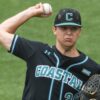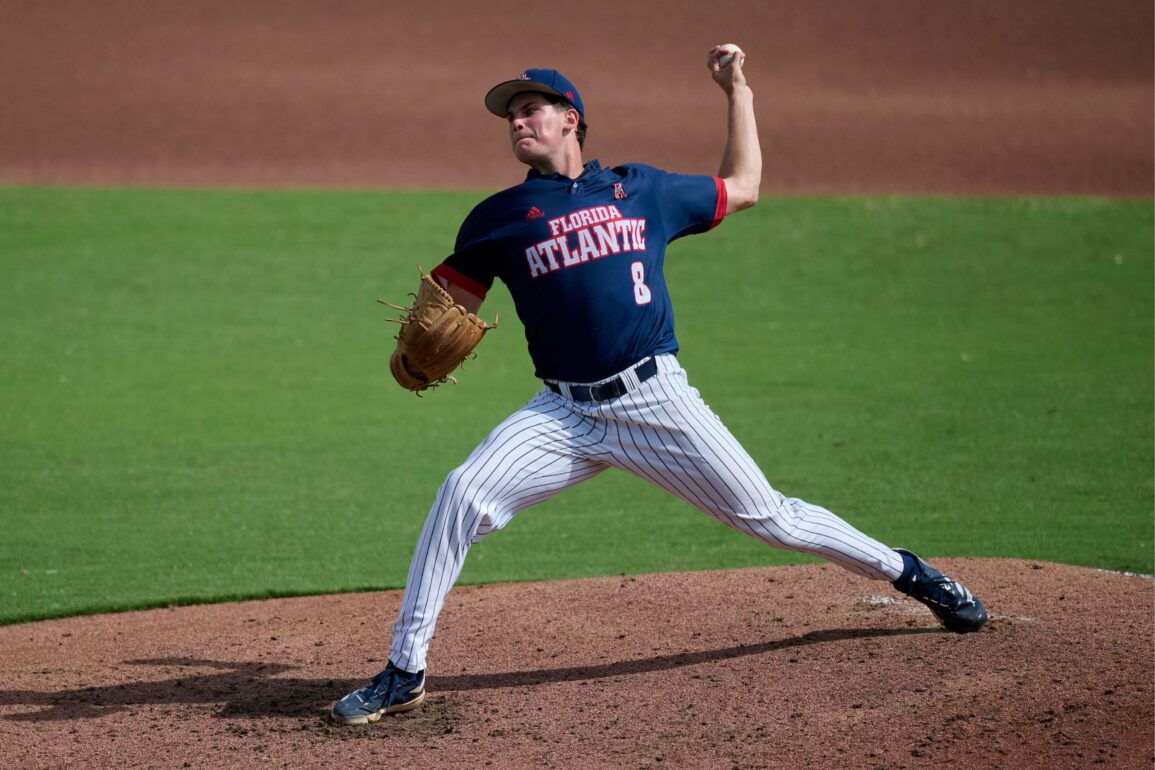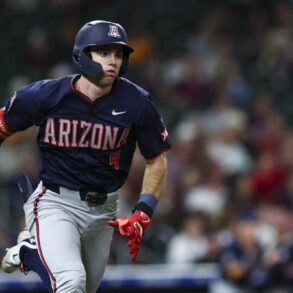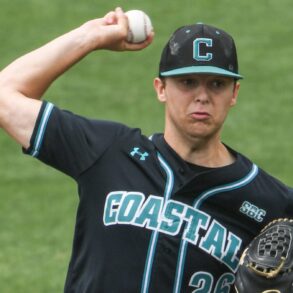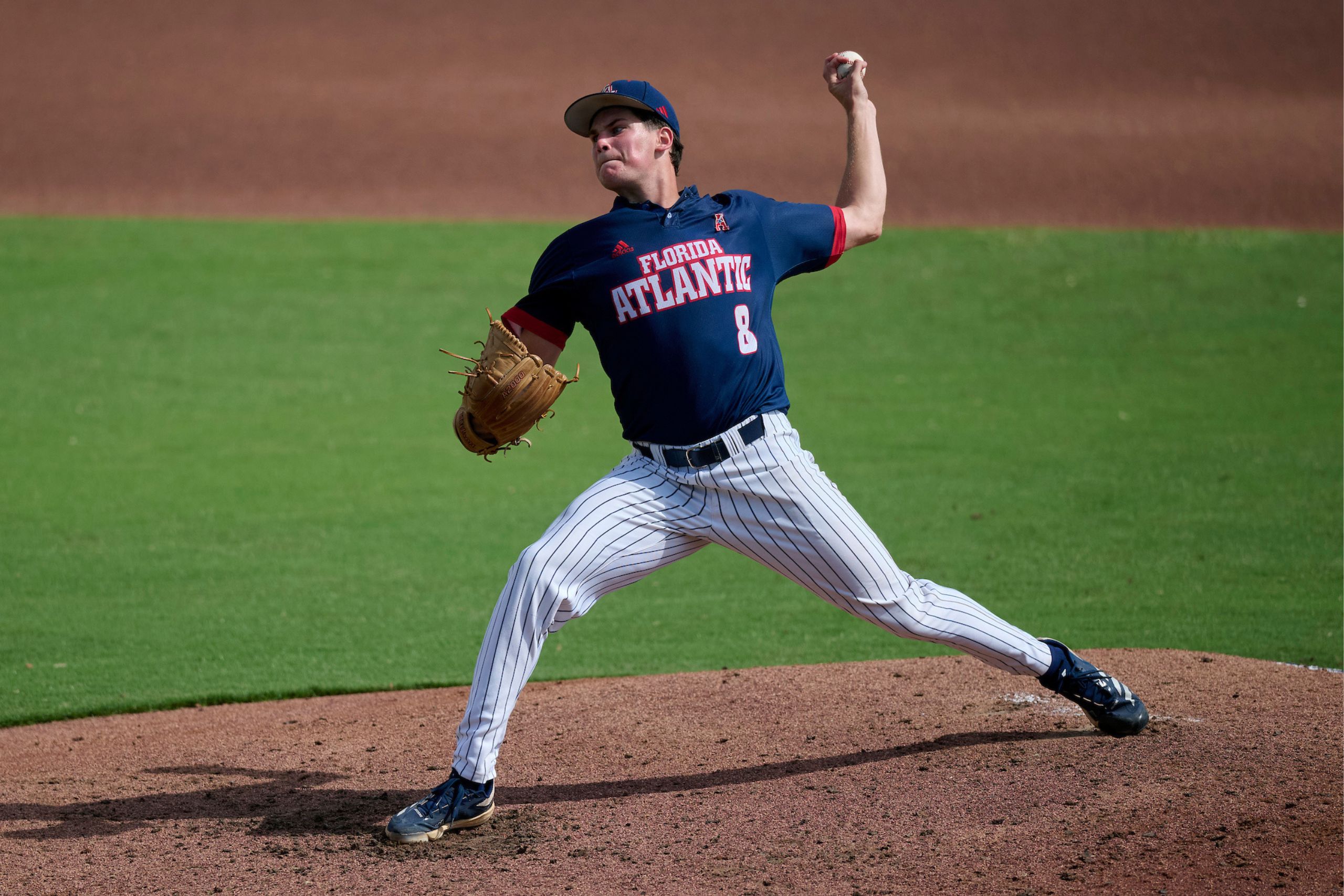
The 2025 MLB draft is almost exactly one month away. At the same time, a big summer circuit is about to get underway for next year’s 2026 prospects across the country.
Today, we’ll be taking a look at scouting reports for 10 prominent 2026-eligible players who have raised their respective draft stock this season. Spoiler alert: All will be ranked in a prominent spot on our next 2026 draft rankings update that will be released next month, so this list should serve as a good primer for names to follow heading into next year.
It’s important to keep in mind that this is not a ranking and the players are listed alphabetically.
Trey Beard, LHP, Transfer Portal
Beard was already ranked in a prominent spot (No. 36) on the first iteration of our 2026 college rankings, but he’ll be much higher than that in our next update. The lefthander pitched his way to a 3.14 ERA with an impressive strikeout-to-walk ratio of 118-to-32 across 86 innings with Florida Atlantic this year. If it wasn’t for Charlotte righthander Blake Gillespie, Beard would have taken home AAC pitcher of the year honors.
Beard attacks from a straight over-the-top slot and a tough-to-pick-up 6-foot-9 release height. His fastball sits in the low 90s, but it jumps out of his hand and has plenty of natural carry up in the zone. He does an outstanding job of maintaining arm speed on his mid-70s changeup that gets fantastic separation off his heater, making it an unbelievably difficult change of pace for opposing hitters. It’s a plus pitch that flashes consistent tumble. Beard also features a mid-70s curveball that flashes big-time depth and downward bite, as well as a mid-to-upper-70s slider that is distinct in shape with lateral life.
Cole Carlon, LHP, Arizona State
Fresh off an impressive summer in the Alaska League, Carlon this year cemented himself as one of the most dominant relievers in the country to the tune of a 3.33 ERA with 86 strikeouts to 25 walks across 54 innings.
A strapping 6-foot-5 southpaw, Carlon is armed with an effective two-pitch mix that consists of a mid-to-upper-90s fastball and a mid-to-upper-80s power slider. His fastball averaged 94.3 mph and was up to 98 with some carry in the top half of the zone, but his slider is his money-maker. Carlon uses it more than his fastball, and it’s a no-doubt plus pitch for which he has an advanced feel. It’s a power gyro that’s effective against both righthanded and lefthanded hitters, and this spring it generated a gaudy 56% miss rate.
After pitching exclusively in relief this spring, Carlon next season projects to be Arizona State’s Friday starter.
Vahn Lackey, C, Georgia Tech
Lackey last year hit just .214/.330/.381 across 84 at-bats, but he entered this season with a bit of buzz in the wake of an impressive fall. He rode that momentum into the spring, as he slashed .347/.421/.500 with 21 extra-base hits, 42 RBIs and 18 stolen bases.
Lackey has an athletic build with some present strength. He moves well in the box and does the same first move as seemingly every Georgia Tech hitter. Lackey has a quick swing with present bat speed and is consistently on the barrel. While he is a hit-over-power profile right now, he has shown the ability to generate quality contact on a regular basis, especially to the pull side. If he gets more aggressive on pitches in the zone, particularly those located in his “nitro zone,” that should only enhance his production.
Lackey also stands out for his defensive ability. His athleticism is evident, and he moves well laterally. He possesses a strong arm, though his actions are particularly advanced. He has quiet and compact footwork to go along with ultra-quick transfers. If Lackey is able to get his throws down to second base more elevated and up off the grass on a more consistent basis, that will only enhance his already-enticing defensive package.
It’s somewhat rare to describe a catcher as “toolsy,” but Lackey certainly fits the description.
Kade Lewis, CIF, Wake Forest
Lewis burst onto the scene last spring at Butler and took home Big East freshman of the year honors. He proceeded to enter the transfer portal and eventually committed to Wake Forest, where he didn’t miss a step, hitting .376/.482/.602 with 18 doubles, 11 home runs, 59 RBIs and a one-to-one strikeout-to-walk ratio.
Lewis has a strong build, especially in his lower half, and has a simple operation in the box in which he takes a direct path to contact. Lewis has a pull-oriented approach and a knack for being on the barrel. He has a sound approach, and his contact skills are a tick above-average. There’s a chance he ends up at first base when all is said and done, but that isn’t too much of a detractor considering the bat is what’s driving his draft stock.
Lucas Moore, OF, Louisville
Moore opened eyes last summer in the Northwoods League, where he hit .340/.432/.416 with 16 extra-base hits, 47 RBIs, an eye-popping 48 stolen bases and more walks (37) than strikeouts (32). He didn’t miss a beat this spring and posted a .352/.448/.474 slash line with 18 extra-base hits, 48 RBIs, 51 stolen bases (against just one caught stealing) and 34 walks to just 23 strikeouts.
Moore has a short, quick swing that is geared towards peppering all parts of the field with line drives. His hit tool is comfortably plus, and he boasts double-plus bat-to-ball skills and a high-level approach.
Speaking of “double-plus,” Moore is a 70-grade runner. Not only is his raw speed ultra-impressive, but he also knows how to use it, which makes him that much more of a threat. He isn’t a free-runner, but rather someone who picks his spots, executes different leads and is a chaos-causer. Simply put, Moore is a nightmare for opposing teams to deal with. His speed and athleticism translate well to center field, though his arm is a bit light.
Ace Reese, 3B, Mississippi State
Reese had one of the most productive seasons of any transfer—especially of the underclass variety—in the country. After a solid freshman year at Houston, Reese this year was named the SEC’s newcomer of the year after hitting .352/.422/.718 with 18 doubles, 21 home runs and 66 RBIs across 57 games.
Reese has a pro body and stands at 6-foot-3, 205 pounds. He moves well in the box, with a fairly compact operation in which he has present bat speed and consistently gets off quick, tight turns with his hips.
Reese has an ultra-enticing hit-power combination. His game power is comfortably plus, and he’s also flashed an above-average hit tool. Reese’s swing decisions took a step in the right direction, and he also posted an in-zone contact rate of 89%. He hammers the baseball to all fields, is consistently on the barrel and generates high-quality contact on a regular basis. There is plenty to love offensively, and if I were to pick a sleeper to go 1-1 in 2026, it would be Reese.
Chris Rembert, 2B, Auburn
Auburn brought in one of the best freshman classes of any school in the country, and Rembert enjoyed the most productive season out of anyone. He was a key cog in Auburn’s super regional lineup and hit .344/.467/.555 with 14 doubles, 10 home runs and 37 walks to 36 strikeouts.
Rembert has an athletic build with strength and physicality in his lower half. He has a rather simple operation in the box in which his hands don’t drift much in his load. He wraps his bat slightly, but he has plus bat speed, and his barrel really accelerates through the hitting zone. He has already flashed impact to the pull side with a budding feel for the barrel.
Rembert has carved out a role as Auburn’s every day second baseman, which is where his actions best profile defensively.
Sawyer Strosnider, OF, TCU
Following a slow start in which he was hitting just .167 through March 2, Strosnider exploded and ended up posting a gaudy .350/.420/.650 line with 13 doubles, a nation-leading 10 triples, 11 home runs and 51 RBIs en route to taking home Big 12 freshman of the year honors. H
Strosnider fits the description of “tooled out” to a tee. He has plenty of bat speed, plus raw power—especially to the pull side—and a plus arm. He’s also a plus runner who’s a center fielder by trade, but likely profiles best in a corner outfield spot long term.
The biggest key for Strosnider going forward will be adding a coat or two of polish to his hit tool, though this year he flashed above-average bat-to-ball skills.
Carson Tinney, C, Notre Dame
After logging just 56 at-bats as a freshman last spring, Tinney enjoyed one of the biggest breakout campaigns of any hitter in the country. The first team all-ACC backstop hit .348/.498/.753 with 13 doubles, 17 home runs and 53 RBIs.
At 6-foot-3 and 220-pounds, Tinney is plenty physical with no shortage of natural strength. He has a simple and rhythmic operation in the box featuring plus bat and hand speed. Tinney has a pull-heavy approach to go along with plus raw and—most importantly—game power, especially to the pull side. The main area of improvement for Tinney is his ability to pick up spin and see shapes out of the hand. There is some miss and chase against secondaries, though it hasn’t been a hindrance to this point.
While he’s slightly large for the position, Tinney is an advanced defender behind the dish. He has a plus, accurate arm as well as advanced footwork and direction. He possesses high-level catch-and-throw skills, and he figures to stick at the position long term. He very well could be the first catcher of the board next July.
Garrett Wright, C, Transfer Portal
One of the only mid-major players in today’s piece, Wright is fresh off an outstanding sophomore campaign for Bowling Green in which he hit .396/.506/.644 with 31 extra-base hits—including 20 doubles—with 48 RBIs and more walks (24) than strikeouts (23).
At 5-foot-11 and 185 pounds, Wright has a prototypical catcher’s build with particular strength and physicality in his lower half. He stands fairly tall in the box with an open front side and wraps his bat slightly in his load. Wright has quickness in his hands and stands out for his bat-to-ball skills and general hit-ability.
This season, he ran an 89% overall in-zone contact rate, including 94% against fastballs. Wright is comfortable using the entire field, though his highest quality of contact comes to the pull side. As a rather impressive cherry on top, Wright is one of three sophomores to have a wRC+ above 150 and a strikeout-percentage below 9.5%. The other two? Roch Cholowsky and Chris Hacopian.
Wright has a solid foundation defensively, headlined by a strong arm. There is some low hanging fruit to clean up, but Wright is on track to stick at the position long-term.
This post was originally published on this site be sure to check out more of their content.




